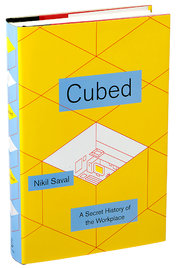
Source of book image: online version of the NYT review quoted and cited below.
(p. C21) I’ve spent about half my working life sitting in, and loathing, cubicles. You’ve probably spent years in one, too. About 60 percent of us work in cubicles, and 93 percent of us dislike them.
. . .
(p. C31) Mr. Saval describes the image we have of the cubicle today: “the flimsy, fabric-wrapped, half-exposed stall where the white-collar worker waited out his days until, at long last, he was laid off.”
. . .
When he discovers that half of Americans report that their bathrooms are larger than their cubicles, for example, he writes: “One wonders to what extent the extravagant growth of the American bathroom, and of the suburban home in general, is partly a reaction against the shrinking of cubicles, where the owners of those bathrooms spend so much of their time.”
. . .
Putting a spin on Rousseau, he says,
. . .
By the end of “Cubed,” the author is dropping in on Silicon Valley offices, where companies like Google cater to their employees’ every need, almost eliminating the distinction between work and leisure. Mr. Saval savors the fact that so many well-known Silicon Valley figures dropped out of college yet want their offices to resemble college campuses.
For the full review, see:
DWIGHT GARNER. “Books of The Times; The Office Space We Love to Hate.” The New York Times (Fri., APRIL 25, 2014): C21 & C31.
(Note: ellipses added.)
(Note: the online version of the review has the date APRIL 24, 2014.)
The book under review is:
Saval, Nikil. Cubed: A Secret History of the Workplace. New York: Doubleday, 2014.

